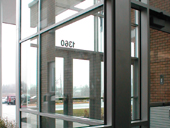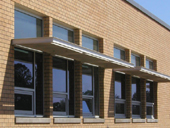

Upon visiting the school, the team observed that the same shade design was used for the east, west, and south elevations. (The north elevations do not have sunshades due to the limited amount of direct sun exposure.) It is a simple horizontal projection, very effective for south facing windows when the sun is high in the sky. There was a mutual feeling that this design would not be effective for east and west facing windows when the angle of the sun is lower, especially in the early morning and late afternoon. This observation lead directly to the focus of this case study - analyzing and comparing the performance of each orientation.

